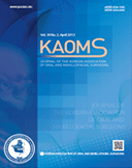Journal of the Korean Association of Oral and Maxillofacial Surgeons
- P-ISSN2234-7550
- E-ISSN2234-5930
- SCOPUS, KCI, ESCI
 ISSN : 2234-7550
ISSN : 2234-7550
Comparison of immunohistochemical analysis on sinus augmentation using demineralized tooth graft and bovine bone
Kim Ji-Rak (Department of Oral Medicine, School of Dentistry, Kyungpook National University, Daegu, Korea)
Kim Hyung-Gyun (Department of Dentistry and Oral and Maxillofacial Surgery, School of Medicine, Daegu Catholic University, Daegu, Korea)
Choi Hyun-Suk (Department of Dentistry and Prosthodontics, School of Medicine, Daegu Catholic University, Daegu, Korea)
Moon Yong-Suk (Department of Anatomy, School of Medicine, Daegu Catholic University, Daegu, Korea)
Abstract
Objectives: The purpose of this animal research was to compare bone regeneration in augmented rabbit maxillary sinuses treated with demineralized particulate human-tooth graft and anorganic bovine bone by immunohistochemical analysis. Materials and Methods: Piezoelectric bilateral sinus augmentation was performed in eight adult rabbits. In the control group, anorganic bovine was grafted in the maxillary sinus following elevation of the sinus membrane. In the experimental group, demineralized human particulate tooth bone was grafted in the sinus. Bone regeneration in augmented sinuses was evaluated by immunohistochemical analysis using various markers of osteoprogenitor cells. Results: The number of bromodeoxyuridine-labeled cells was significantly higher in the experimental group than in the control group at eight weeks. The immunoreactivity of proliferating-cell nuclear antigen was increased slightly in the experimental group relative to the control group at eight weeks. Other bone markers were expressed equally in the two groups. Conclusion: In the rabbit maxillary sinus, higher osteoinduction was correlated with demineralized human particulate tooth bone grafting than with anorganic bovine grafting.
- keywords
- Maxillary sinus lift, Demineralized tooth bone, Replaceable bony window, Immunohistochemical assay
- 다운로드 수
- 조회수
- 0KCI 피인용수
- 0WOS 피인용수